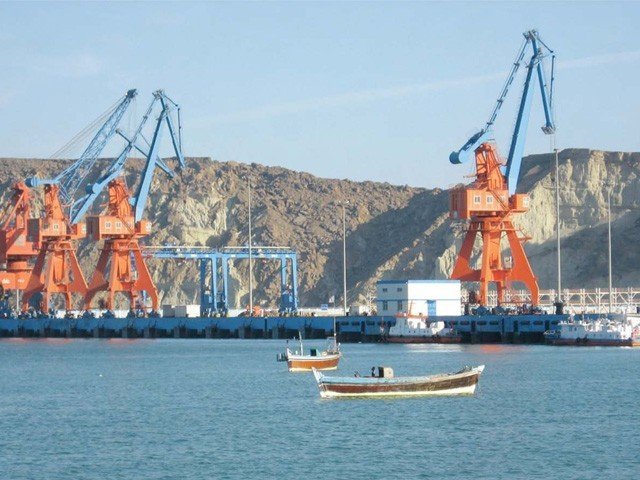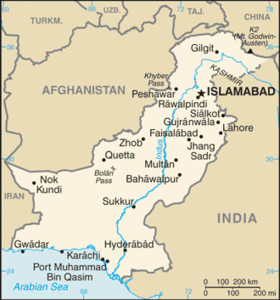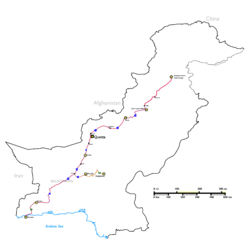The Gwadar Port (Urdu: گوادر بندرگاه ; IPA: gʷɑːd̪əɾ bənd̪əɾgɑː) is a deep-sea port situated on the Arabian Sea at Gwadar in Balochistan province of Pakistan. The port features prominently in the China–Pakistan Economic Corridor (CPEC) plan, and is considered to be a link between the ambitious One Belt, One Road and Maritime Silk Road projects.[1]

Gwadar's potential to be a deep water sea port was first noted in 1954, while the city was still under Omani suzerainty.[2] Plans for construction of the port were not realised until 2007, when the port was inaugurated by Parvez Musharraf after four years of construction, at a cost of $248 million.[3]
In 2015, it was announced that the city and port would be further developed under CPEC at a cost of $1.62 billion,[4] with the aim of linking northern Pakistan and western China to the deep water seaport.[5] The port will also be the site of a floating liquefied natural gas facility that will be built as part of the larger $2.5 billion Gwadar-Nawabshah segment of the Iran–Pakistan gas pipeline project.[6] Construction began in June 2016 on the Gwadar Special Economic Zone, which is being built on 2,292 acre site adjacent to Gwadar's port.[7] In late 2015, the port was officially leased to China for 43 years, until 2059.[8]
Gwadar Port became formally operational on 14 November 2016, when it was inaugurated by Pakistan's Prime Minister Muhammad Nawaz Sharif; the first convoy was seen off by Pakistan's Chief of Army Staff, General Raheel Sharif. The four main benefits of Gawader It could act as a port for western china via karakoram highway It could act as a port for the new land locked central Asian states It could enable development of balochistan It would lie on the imp sea route through the straits of hormuz [9]
Location

Gwadar Port is located in southwestern Pakistan near the Iranian border
Gwadar Port is sitatuated on the shores of the Arabian Sea in the city of Gwadar, located in the Pakistani province of Balochistan. The port is located 533 km from Pakistan's largest city, Karachi, and is approximately 120 km from the Iranian border. It is located 380 km (240 mi) away from Oman, and near key oil shipping lanes from the Persian Gulf. The greater surrounding region is home to around two-thirds of the world's proven oil reserves. It is also the nearest warm-water seaport to the landlocked, but hydrocarbon rich, Central Asian Republics, as well as Afghanistan.[10]
The port is situated on a rocky outcropping in the Arabian sea that forms part of a natural hammerhead-shaped peninsula protruding out from the Pakistani coastline.[11] The peninsula, known as the Gwadar Promentory, consists of rocky outcropping reaching an altitude of 560 feet with a width of 2.5 miles that are connected to the Pakistani shore by a narrow and sandy 12 kilometre long isthmus.[12] The isthmus separates the shallow Padi Zirr bay to the west, from the deep water Demi Zirr harbour in the east.
Background
akistan identified Gwadar as a port site as far back as 1954 when Gwadar was still under Omani rule.[13] Pakistan's interest in Gwadar started when, in 1954, it engaged the United States Geological Survey (USGS) to conduct a survey of its coastline. The USGS deputed the surveyor, Worth Condrick, for the survey, who identified Gwadar as a suitable site for a seaport.[13] After four years of negotiations, Pakistan purchased the Gwadar enclave from Oman for US$3 million on 8 September 1958 and Gwadar officially became part of Pakistan on 8 December 1958, after 200 years of Omani rule.[13]
A small wharf at Gwadar was completed in 1992, and formal proposals for a deep sea port at Gwadar were unveiled a year later in 1993.[14] The federal government approved the construction of the port in December 1995 but the project could not get started because of shortage of funds. In 1997, a government-appointed task force identified Gwadar as one of the focus area of development, but the project did not launch due to economic sanctions imposed against Pakistan following its nuclear tests in May 1998.[13] Construction on Phase 1 of the project began in 2002 after the agreement for its construction was signed during the state visit of Chinese Premier Zhu Rongji in 2001.[15] After completion of Phase 1 in 2007, the first commercial cargo vessel to dock at the port was the "Pos Glory," with 70,000 Metric Tonnes of Wheat on 15 March 2008.[16]
Construction
Gwadar Port is being developed in two phases: Phase I covered building of three multipurpose berths and related port infrastructure and port handling equipment, and was completed in December 2006, but inaugurated on 20 March 2007.
Phase I (2002–2006)
The first phase of construction at Gwadar Port began in 2002, and was completed in 2006, before inauguration in 2007.[18]
Berths: 3 Multipurpose Berths (capacity: bulk carriers of 30,000 deadweight tonnage [DWT] and container vessels of 25,000 DWT)[19]
Length of Berths: 602 m in total
Approach Channel: 4.5 km long dredged to 12.5 m depth
Turning basin: 450 m diameter
Service Berth: One 100 m Service Berth
Related port infrastructure and handling equipment, pilot boats, tugs, survey vessels, etc.
Built at a cost of $248 million.[3]
Phase II (ongoing)
The second phase of construction is currently underway as part of planned improvements under CPEC and other ancillary projects. The total project is expected to cost $1.02 billion.[20]
4 Container Berths along 3.2 kilometres of shoreline
1 Bulk Cargo Terminal (capacity: 100,000 DWT ships)
1 Grain Terminal
1 Ro-Ro Terminal
2 Oil Terminals (capacity: 200,000 DWT ships each)
Approach Channel: To be dredged to 14.5 m depth
4 lane expressway to connect the port to the Makran Coastal Highway
New international airport to be built in vicinity of the port
Floating liquefied natural gas terminal with capacity of 500 million cubic feet of gas per day
2,292 acre special economic zone to be developed adjacent to port
Desalination plant
360 megawatt coal-fired power plant
Longer term plans
Longer term plans Edit
Dredging of approach channel to depth of 20 meters
150 berths to be built by 2045
Capacity to handle 400 million tons of cargo per year
Expansion under CPEC

The Western Alignment of CPEC is depicted by the red line. The 1,153 kilometre route will link the M1 Motorway near Islamabad with Gwadar Port. The Western Alignment will also connect to the Karakoram Highway, which is being rebuilt and overhauled as part of CPEC to provide improved access to Gilgit Baltistan and the Chinese region of Xinjiang.
Under the China-Pakistan Economic Corridor plan, China Overseas Port Holding Company (COPHC) will expand Gwadar Port with construction of nine new multipurpose berths on 3.2 kilometres of seafront to the east of the existing multipurpose berths.[21] COPHC will also build cargo terminals in the 12 kilometres of land to the north and northwest of the site along the shoreline of the Demi Zirr bay.[21]
In total, COPHC has awarded $1.02 billion worth of contracts for expansion of the port.[20] In addition to construction of nine berths and cargo terminals, plans for expanded port infrastructure also include several projects that will be financed by loans extended by Chinese state owned banks. The Gwadar Port dredging project will deepen approach channels to a depth of 14 meters from the current 11.5-meter depth, at a cost of $27 million.[22] Dredging will enable docking of larger ships with a deadweight tonnage of up to 70,000 at Gwadar Port,[5] while current capacity permits a maximum 20,000 DWT.[23] Future plans call for dredging of the harbour to a depth of 20 meters to allow for docking of larger vessels.[24] Also included as part of the CPEC infrastructure development package for port infrastructure is a $130 million breakwater around the port.[25]
Ancillary infrastructure projects for the port will also be built as part of CPEC. A $114 million desalination plant will be developed to provide potable water to the city, while the Government of Pakistan will also contribute $35 million towards infrastructure projects in the Gwadar Special Economic Zone.[26][27] A 19 kilometre-long dual carriageway known as the Gwadar East Bay Expressway will also be built at a cost of $140 million to connect Gwadar Port to the existing Makran Coastal Highway and the planned $230 million Gwadar International Airport.[28]
A floating liquefied natural gas facility that will have a capacity of 500 million cubic feet of liquified natural gas per day will also be built at the port as part of the $2.5 billion Gwadar-Nawabshah segment of the Iran–Pakistan gas pipeline,[6] which is being built as a joint venture between Pakistan's Inter State Gas System, and the China National Petroleum Corporation.[29] The Pakistani government also intends to establish a training institute named Pak-China Technical and Vocational Institute at Gwadar which is to be completed at the cost of 943 million rupees to impart skills to local residents to train them to operate machinery at the port.[30]
It is expected that by 2017, the port will handle over one million tons of cargo,[31] most of which will consist of construction materials for other CPEC projects.[32] COPHC plans to eventually expand the port's capacity to 400 million tons of cargo per year.[33] Long terms plans for Gwadar Port call for a total of 100 berths to be built by 2045.[34]
Financing
Financing Edit
The government of China in August 2015 announced that the previously announced concessionary loans for several projects in Gwadar totalling $757 million would be converted 0% interest loans for which Pakistan will only be required to repay the principal value.[25] The projects which are now to financed by the 0% interest loans include: the construction of the $140 million East Bay Expressway project, installation of breakwaters in Gwadar which will cost $130 million, a $360 million coal power plant in Gwadar, a $27 million project to dredge berths in Gwadar harbour, and a $100 million 300-bed hospital in Gwadar.[25]
In September 2015, the government of China also announced that the $230 million Gwadar International Airport project would no longer be financed by loans, but would instead be constructed by grants which the government of Pakistan will not be required to repay.[35]
Gwadar Special Economic Zone
The expanded port will be located near a 2,282 acre free trade area in Gwadar which is being modelled on the lines of the Special Economic Zones of China.[36] The swathe of land was handed to the China Overseas Port Holding Company in November 2015 as part of a 43-year lease,[37] while construction of the project began on 20 June 2016.[38] The special economic zone is expected to employ approximately 40,000 people,[39] with possibility for future expansion.[40]
The special economic zone will include manufacturing zones, logistics hubs, warehouses, and display centres.[41] Business established in the special economic zone will be exempt from Pakistani income, sales, and federal excise taxes for 23 years.[42] Contractors and subcontractors associated with China Overseas Port Holding Company will be exempt from such taxes for 20 years,[43] while a 40-year tax holiday will be granted for imports of equipment, materials, plants, machinery, appliances and accessories that are to be for construction of Gwadar Port and special economic zone.[44]
The special economic zone will be completed in three phases. By 2025, it is envisaged that manufacturing and processing industries will be developed, while further expansion of the zone is intended to be complete by 2030.[30] On 10 April 2016, talking to The Washington Post, Zhang Baozhong, chairman of China Overseas Port Holding Company said that his company could spend a total of $4.5 billion on roads, power, hotels and other infrastructure for the industrial zone, which he said would be open to non-Chinese companies. The company also plans to build an international airport and power plant for Gwadar.[45]
Operations
wadar Port is owned by the government-owned Gwadar Port Authority[46] and operated by state-run Chinese firm — China Overseas Port Holding Company (COPHC).[47] Prior to COPHC, the port was operated by the Port of Singapore Authority.
Port of Singapore Authority (2007–2013)
Following the completion of Phase I, the Government of Pakistan in February 2007 signed a 40-year agreement with PSA International for development and operation of the port, and an adjacent 584 acre special economic zone.[48] PSA International was the highest bidder for the Gwadar port, after its competitor DP World withdrew from the bidding process.[49] PSA was granted a wide range of tax concessions, including exemption from corporate tax for 20 years, land for a special economic zone, duty-free imports of materials and equipment for construction and operations of the port, and duty-free shipping and bunker oil for 40 years. In addition to these incentives, the provincial government of Balochistan was also asked to exempt PSA International from the levy of provincial and district taxes. According to the agreement with PSA, the Government of Pakistan was to get a fixed 9% share of the revenue from cargo and maritime services, in addition to 15% of revenues earned from the adjacent special economic zone.
In September 2011, the Wall Street Journal reported that Gwadar was being underused as commercial port, and that Pakistan had asked the Chinese government to assume operations of the port.[50] PSA also reportedly sought to withdraw from its contract with the Pakistani Government, and expressed willingness to sell its share in the project to a Chinese firm after the Pakistani Navy failed to transfer land required for development of the planned 584 acre free trade zone.[48] PSA also did not invest the agreed $550 million into the port, on account of the poor security situation in Balochistan in the period between 2007 and 2013.[48] The government of Pakistan also failed to invest in requisite infrastructure works.[51] The Supreme Court of Pakistan further issued a stay order against the allotment of land to PSA on account of a public petition.[48]
China Overseas Port Holding Company (2013–present)
On 18 February 2013, Pakistan awarded a contract for construction and operation of Gwadar Port to China. As per details of the contract, the port would remain as property of Pakistan, but would be operated by the state-run Chinese firm – China Overseas Port Holding Company (COPHC).[52] The contract signing ceremony was held on 18 February 2013 in Islamabad, and was attended by Pakistani President Asif Ali Zardari, Chinese Ambassador Liu Jian, as well as various federal ministers and members of parliament, as well as senior government officials.[52] The ceremony was also marked the transfer of the concession agreement from the PSA to the COPHC.[52]
Gwadar Port as a means to circumvent the Straits of Malacca
The Straits of Malacca provide China with its shortest maritime access to Europe, Africa, and the Middle East.[53] Approximately 80% of its Middle Eastern and African energy imports also pass through the Straits of Malacca.[54] As the world's biggest oil importer,[55] energy security is a key concern for China while current sea routes used to import Middle Eastern and African oil are frequently patrolled by the United States' Navy.[56] The sea-route via the Straits of Malacca is roughly 12,000 kilometres long, while the distance from Gwadar Port to Xinjiang province is approximately 3,000 kilometres, and another 3,500 kilometres from Xinjiang to China's eastern coast.[54]
In the event that China were to face hostile actions from a state or non-state actor, energy imports through the Straits of Malacca could be halted, which in turn would paralyse the Chinese economy in a scenario that is frequently referred to as the "Malacca Dilemma".[54] In addition vulnerabilities faced in the Straits of Malacca region, China is heavily dependent upon sea-routes that pass through the South China Sea, near the disputed Spratly Islands and Paracel Islands, which are currently a source of tension between China, Taiwan, Vietnam, the Philippines, and the United States.[57] The CPEC project will allow Chinese energy imports to circumvent these contentious areas, and thereby decrease the possibility of confrontation between the United States and China.[58]
In addition to potential weaknesses in regards to the United States' Navy, the Indian Navy has recently increased maritime surveillance of the Straits of Malacca region from its base on Great Nicobar Island.[59] India has expressed fears of a Chinese "String of Pearls" encircling it.[60][61] Were conflict to erupt, India could potentially impede Chinese imports through the straits.[62] Indian maritime surveillance in the Andaman Sea could possibly enhance Chinese interest in Pakistan's Gwadar Port – the Kyaukpyu Port, which is currently being developed in Myanmar by the Chinese government as another alternate route around the Straits of Malacca, will likely be vulnerable to similar advances by the Indian Navy. The proposed Bangladesh-China-India-Myanmar Corridor (BCIM) would also be vulnerable to Indian advances against China in the event of conflict, thereby potentially limiting the BCIM Corridor's usefulness to China's energy security, and thereby increasing Chinese interest in CPEC.
Congratulations @raeesbaloch! You have completed some achievement on Steemit and have been rewarded with new badge(s) :
Click on any badge to view your own Board of Honor on SteemitBoard.
To support your work, I also upvoted your post!
For more information about SteemitBoard, click here
If you no longer want to receive notifications, reply to this comment with the word
STOPHi! I am a robot. I just upvoted you! I found similar content that readers might be interested in:
https://ipfs.io/ipfs/QmXoypizjW3WknFiJnKLwHCnL72vedxjQkDDP1mXWo6uco/wiki/Gwadar_port.html